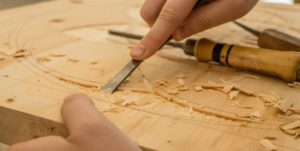
How Play Lights up Your Brain
Give yourself a break from performance pressures by adopting a playful mindset. Let fun sharpen your mind and memory.

Image by Clay Banks from Unsplash
As kids we told stories, created games, and went on adventures in our backyards – just for the fun of it. Our brains lit up and grew as we played. As adults, the need to achieve in so many areas of life mean many of us have forgotten how to do something ‘just for the fun of it’. Remembering our playful selves not only activates our creative brain, but helps us respond more flexibly and work smarter, leaving more time for… fun.

Artist: Allison Adams. See more of her Groundbreaking Girls collection here.
Ruth Bader Ginsburg had to be a very serious person, right? As the first woman to become an associate justice of the US Supreme Court she was feisty. When it came to justice, according to one of her clerks, she was pretty scary. Yet, with her recent passing, her life is warmly remembered for her care, wisdom and advocacy. She says play helped her.
She said she owes her success in law school to her daughter, Jane. After going to a full day of classes, she would return home to her 14-month-old daughter just as the nanny left at 4pm. This was Ruth’s play time, until Jane fell asleep. It was their pleasure time together. After this break, Ruth could continue with the books again.
“So I felt each part of my life gave me respite from the other. And I wasn’t so overwhelmed thinking that my whole world was the law school. I think I had a better balance, better sense of proportions of what matters.”
A Time to Remember
When you think about how much of your day as a grown-up is taken up with To Do lists, goals and tasks, it comes as no surprise that in our performance-based culture we’re losing the knack for creating and imagining. Things like:
Exploring a pathway without knowing where it’s going.
Wondering about something as we turn it over in our hands.
Daydreaming about our dreams coming true.

Image by Sarah Richter from Pixabay
Carl Jung, the founder of analytic psychology, once looked for a way to retrieve his childhood creativity. He said of himself,
“The small boy is still around, and possesses a creative life which I lack. But how can I make my way to it?” His solution was to go back to the play activities he’d enjoyed as a child.
Modern-day play expert, Dr Stuart Brown, says the same thing. He encourages adults to go back as far as we can to our clearest, most joyful, playful image that we have, and build from the emotion of that. He speaks of lives transformed by unlocking passions and inner drives from these happy memories.
So How Will Play Sharpen Up Your Brain?
Rediscovering play not only reintroduces a sense of wonder and revelry into our lives—it’s significantly good for our brains too.
- Play Activates Your Brain All Over
By its nature, play promotes curiosity and exploration. Very often it involves doing something with your hands. As soon as your hands reach out and begin manipulating something in 3D, the cerebellum is fired up, which sends impulses to your frontal lobe, where your executive skillskick in. When this happens, you’re developing your working memory.

Image by Dominik Scythe from Unsplash
The simple acts of mixing cookie dough, tinkering inside the bonnet of a car, or playing the piano are physiologically tuning up your brain. The neurological processes involved are making you a better problem solver.
- If it was Fun, You’re More Likely to Remember It
Adult learning is more likely to stick when it’s something enjoyable, like trying out a new hobby or exploring a new place.
When last did you fun-learn? A time you
laughed
moved
heard stories or
did ‘hands on’ stuff
… on a course or in a meeting or at training. Compare how much you remember of that to how much you remember of the last news bulletin you watched. The playfulness in fun-learning stimulates your contextual memory, which is your recall of an event.
- Play Triggers Creativity and Innovation
Dr Brown advises that rather than slotting play appointments into our schedules, we should aim for a state of play to be infused into all that we do – work, home, family, wherever. Engaging in play through our bodies, through objects, and with other people will enrich our lives by changing the way we think.
Workplaces are catching onto this. Neuroscience now backs the advantages of playfulness for increasing productivity and innovation. More employees are being allowed out to play during a working day. Whether a snatch of table tennis, a group relaxation session or an afternoon social, playful employees are less likely to become overwhelmed by work. Studies find playful workers to be happier, more satisfied at work and more likely to come to work.
11 Playful Ways to Stimulate Your Synapses
Invite Fun as a VIP

Image by SplitShire on Pixabay
- Write a limerick about someone you know and send it to them.
- Print a heap of your favourite phone photos and get family members or housemates to do the same. Pile the pics in a bowl on a coffee table for people to pull out at random. Each will have a story to tell.
- Try a new hobby. Learn to play your favourite song on a guitar or knit your first scarf.
- Eat a fruit or vegetable that you’ve never tried before.
Break the rules
- Who says you have to speak normally? Next time you’re at a restaurant only talk with an accent to the wait staff.
- Dream crazy dreams. Pretend you have no limitations. Create an inspiration board full of pictures and words portraying your heart’s greatest desires, and display it somewhere you’ll see it often. You never know…
- Who said you’re not dance video material? Make a dance video with a friend to your favourite tune and roll on the floor laughing as you watch it. This father and daughter get the vibe.
–
Don’t Overthink It
- Play along with a child, completely following their lead. Don’t make any suggestions, just do exactly what they do or what you’re told. If they seem stuck on what to do with you, ask a question, starting with “I’m wondering …?” And ending with, “What do you think?”
See how Tom Hanks answers kids’ questions, with a good dose of ‘tomfoolery’.
- Up-cycle something. Transform a favourite old T-shirt into a bag, or paint a piece of jewellery. Explore thrift stores, garage sales or your own cupboards for something that needs a new lease on life. Imagine, create and play. Add things, chop things, twist, paint or glue. Doesn’t matter if it doesn’t work out – find glee in the process. Check out these up-cycled clothes for ideas.
- Take a bus or train to a town or city you’ve never visited. Just go to the station and get on the next one that pulls in. See if you can find the most fun thing to do in that place.
OR If you’re not quite that brave, check your local ‘What’s On’ and pick an activity to attend. - You know that thing you’ve always wanted to do, but never been brave enough to do? Rollercoaster rides, fly in a wind tunnel, touch a snake or paint with oils, for example. Grab some people you trust, let your hair down and gambol in new experiences.

Image by Jill Wellington from Pixabay
Over to You
You now have a neuroscientific excuse to play. It’s good for your brain.
Take a trip down memory lane to remember your favourite play activities
Take a play break and light up your brain.
Australians, we have a long weekend to take our brains for a play spin.
Let’s play!
And please tell me about it.
- What’s your earliest happy childhood play memory?
- How do you play in your workplace?
- Do you have a photo or idea to share?
Inspirational References:
- I love this book by Meredith Sinclair: Well-Played: The Ultimate Guide to Awakening Your Family’s Playful Spirit. A number of my ideas for these blogs have come from her insights.
- Dr Stuart Brown’s TED Talk: Play is More Than Fun
- Excerpt by Dottie Ward-Wimmer from book, ‘Play Therapy With Adults’ by C Schaefer. https://www.psychceu.com/Schaefer/intro.pdf
- The Benefits of Play for Adults
- Staying Young at Heart: Why Adults Should be Playing More
